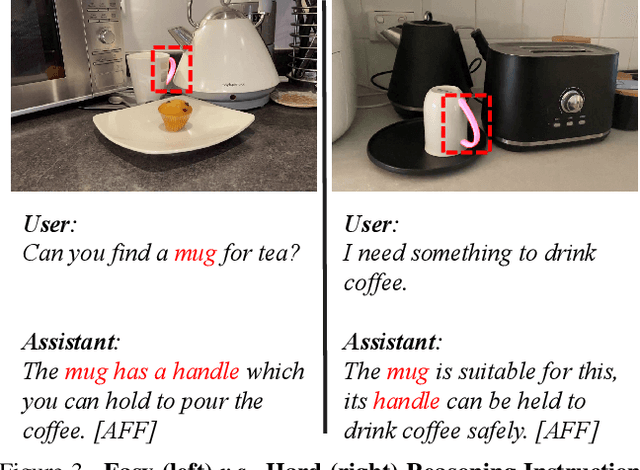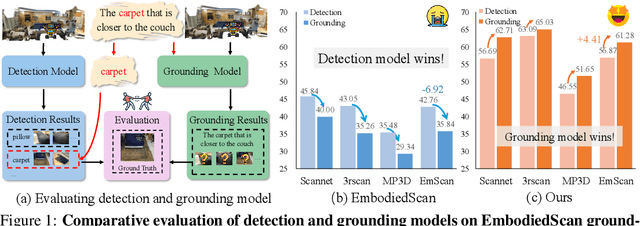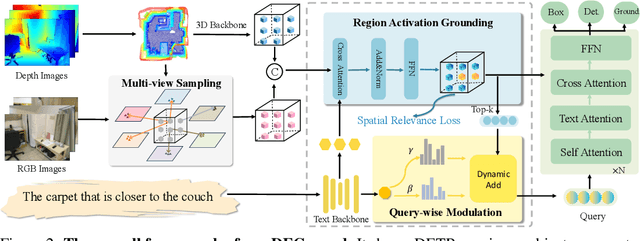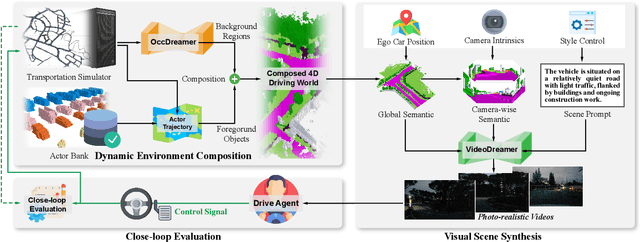Dongming Wu
SpaceVista: All-Scale Visual Spatial Reasoning from mm to km
Oct 10, 2025Abstract:With the current surge in spatial reasoning explorations, researchers have made significant progress in understanding indoor scenes, but still struggle with diverse applications such as robotics and autonomous driving. This paper aims to advance all-scale spatial reasoning across diverse scenarios by tackling two key challenges: 1) the heavy reliance on indoor 3D scans and labor-intensive manual annotations for dataset curation; 2) the absence of effective all-scale scene modeling, which often leads to overfitting to individual scenes. In this paper, we introduce a holistic solution that integrates a structured spatial reasoning knowledge system, scale-aware modeling, and a progressive training paradigm, as the first attempt to broaden the all-scale spatial intelligence of MLLMs to the best of our knowledge. Using a task-specific, specialist-driven automated pipeline, we curate over 38K video scenes across 5 spatial scales to create SpaceVista-1M, a dataset comprising approximately 1M spatial QA pairs spanning 19 diverse task types. While specialist models can inject useful domain knowledge, they are not reliable for evaluation. We then build an all-scale benchmark with precise annotations by manually recording, retrieving, and assembling video-based data. However, naive training with SpaceVista-1M often yields suboptimal results due to the potential knowledge conflict. Accordingly, we introduce SpaceVista-7B, a spatial reasoning model that accepts dense inputs beyond semantics and uses scale as an anchor for scale-aware experts and progressive rewards. Finally, extensive evaluations across 5 benchmarks, including our SpaceVista-Bench, demonstrate competitive performance, showcasing strong generalization across all scales and scenarios. Our dataset, model, and benchmark will be released on https://peiwensun2000.github.io/mm2km .
RAGNet: Large-scale Reasoning-based Affordance Segmentation Benchmark towards General Grasping
Jul 31, 2025



Abstract:General robotic grasping systems require accurate object affordance perception in diverse open-world scenarios following human instructions. However, current studies suffer from the problem of lacking reasoning-based large-scale affordance prediction data, leading to considerable concern about open-world effectiveness. To address this limitation, we build a large-scale grasping-oriented affordance segmentation benchmark with human-like instructions, named RAGNet. It contains 273k images, 180 categories, and 26k reasoning instructions. The images cover diverse embodied data domains, such as wild, robot, ego-centric, and even simulation data. They are carefully annotated with an affordance map, while the difficulty of language instructions is largely increased by removing their category name and only providing functional descriptions. Furthermore, we propose a comprehensive affordance-based grasping framework, named AffordanceNet, which consists of a VLM pre-trained on our massive affordance data and a grasping network that conditions an affordance map to grasp the target. Extensive experiments on affordance segmentation benchmarks and real-robot manipulation tasks show that our model has a powerful open-world generalization ability. Our data and code is available at https://github.com/wudongming97/AffordanceNet.
Grounding Beyond Detection: Enhancing Contextual Understanding in Embodied 3D Grounding
Jun 05, 2025



Abstract:Embodied 3D grounding aims to localize target objects described in human instructions from ego-centric viewpoint. Most methods typically follow a two-stage paradigm where a trained 3D detector's optimized backbone parameters are used to initialize a grounding model. In this study, we explore a fundamental question: Does embodied 3D grounding benefit enough from detection? To answer this question, we assess the grounding performance of detection models using predicted boxes filtered by the target category. Surprisingly, these detection models without any instruction-specific training outperform the grounding models explicitly trained with language instructions. This indicates that even category-level embodied 3D grounding may not be well resolved, let alone more fine-grained context-aware grounding. Motivated by this finding, we propose DEGround, which shares DETR queries as object representation for both DEtection and Grounding and enables the grounding to benefit from basic category classification and box detection. Based on this framework, we further introduce a regional activation grounding module that highlights instruction-related regions and a query-wise modulation module that incorporates sentence-level semantic into the query representation, strengthening the context-aware understanding of language instructions. Remarkably, DEGround outperforms state-of-the-art model BIP3D by 7.52\% at overall accuracy on the EmbodiedScan validation set. The source code will be publicly available at https://github.com/zyn213/DEGround.
Cognitive Disentanglement for Referring Multi-Object Tracking
Mar 14, 2025Abstract:As a significant application of multi-source information fusion in intelligent transportation perception systems, Referring Multi-Object Tracking (RMOT) involves localizing and tracking specific objects in video sequences based on language references. However, existing RMOT approaches often treat language descriptions as holistic embeddings and struggle to effectively integrate the rich semantic information contained in language expressions with visual features. This limitation is especially apparent in complex scenes requiring comprehensive understanding of both static object attributes and spatial motion information. In this paper, we propose a Cognitive Disentanglement for Referring Multi-Object Tracking (CDRMT) framework that addresses these challenges. It adapts the "what" and "where" pathways from human visual processing system to RMOT tasks. Specifically, our framework comprises three collaborative components: (1)The Bidirectional Interactive Fusion module first establishes cross-modal connections while preserving modality-specific characteristics; (2) Building upon this foundation, the Progressive Semantic-Decoupled Query Learning mechanism hierarchically injects complementary information into object queries, progressively refining object understanding from coarse to fine-grained semantic levels; (3) Finally, the Structural Consensus Constraint enforces bidirectional semantic consistency between visual features and language descriptions, ensuring that tracked objects faithfully reflect the referring expression. Extensive experiments on different benchmark datasets demonstrate that CDRMT achieves substantial improvements over state-of-the-art methods, with average gains of 6.0% in HOTA score on Refer-KITTI and 3.2% on Refer-KITTI-V2. Our approach advances the state-of-the-art in RMOT while simultaneously providing new insights into multi-source information fusion.
DrivingSphere: Building a High-fidelity 4D World for Closed-loop Simulation
Nov 18, 2024



Abstract:Autonomous driving evaluation requires simulation environments that closely replicate actual road conditions, including real-world sensory data and responsive feedback loops. However, many existing simulations need to predict waypoints along fixed routes on public datasets or synthetic photorealistic data, \ie, open-loop simulation usually lacks the ability to assess dynamic decision-making. While the recent efforts of closed-loop simulation offer feedback-driven environments, they cannot process visual sensor inputs or produce outputs that differ from real-world data. To address these challenges, we propose DrivingSphere, a realistic and closed-loop simulation framework. Its core idea is to build 4D world representation and generate real-life and controllable driving scenarios. In specific, our framework includes a Dynamic Environment Composition module that constructs a detailed 4D driving world with a format of occupancy equipping with static backgrounds and dynamic objects, and a Visual Scene Synthesis module that transforms this data into high-fidelity, multi-view video outputs, ensuring spatial and temporal consistency. By providing a dynamic and realistic simulation environment, DrivingSphere enables comprehensive testing and validation of autonomous driving algorithms, ultimately advancing the development of more reliable autonomous cars. The benchmark will be publicly released.
Bootstrapping Referring Multi-Object Tracking
Jun 07, 2024



Abstract:Referring multi-object tracking (RMOT) aims at detecting and tracking multiple objects following human instruction represented by a natural language expression. Existing RMOT benchmarks are usually formulated through manual annotations, integrated with static regulations. This approach results in a dearth of notable diversity and a constrained scope of implementation. In this work, our key idea is to bootstrap the task of referring multi-object tracking by introducing discriminative language words as much as possible. In specific, we first develop Refer-KITTI into a large-scale dataset, named Refer-KITTI-V2. It starts with 2,719 manual annotations, addressing the issue of class imbalance and introducing more keywords to make it closer to real-world scenarios compared to Refer-KITTI. They are further expanded to a total of 9,758 annotations by prompting large language models, which create 617 different words, surpassing previous RMOT benchmarks. In addition, the end-to-end framework in RMOT is also bootstrapped by a simple yet elegant temporal advancement strategy, which achieves better performance than previous approaches. The source code and dataset is available at https://github.com/zyn213/TempRMOT.
Is a 3D-Tokenized LLM the Key to Reliable Autonomous Driving?
May 28, 2024Abstract:Rapid advancements in Autonomous Driving (AD) tasks turned a significant shift toward end-to-end fashion, particularly in the utilization of vision-language models (VLMs) that integrate robust logical reasoning and cognitive abilities to enable comprehensive end-to-end planning. However, these VLM-based approaches tend to integrate 2D vision tokenizers and a large language model (LLM) for ego-car planning, which lack 3D geometric priors as a cornerstone of reliable planning. Naturally, this observation raises a critical concern: Can a 2D-tokenized LLM accurately perceive the 3D environment? Our evaluation of current VLM-based methods across 3D object detection, vectorized map construction, and environmental caption suggests that the answer is, unfortunately, NO. In other words, 2D-tokenized LLM fails to provide reliable autonomous driving. In response, we introduce DETR-style 3D perceptrons as 3D tokenizers, which connect LLM with a one-layer linear projector. This simple yet elegant strategy, termed Atlas, harnesses the inherent priors of the 3D physical world, enabling it to simultaneously process high-resolution multi-view images and employ spatiotemporal modeling. Despite its simplicity, Atlas demonstrates superior performance in both 3D detection and ego planning tasks on nuScenes dataset, proving that 3D-tokenized LLM is the key to reliable autonomous driving. The code and datasets will be released.
Merlin:Empowering Multimodal LLMs with Foresight Minds
Nov 30, 2023Abstract:Humans possess the remarkable ability to foresee the future to a certain extent based on present observations, a skill we term as foresight minds. However, this capability remains largely under explored within existing Multimodal Large Language Models (MLLMs), hindering their capacity to learn the fundamental principles of how things operate and the intentions behind the observed subjects. To address this issue, we introduce the integration of future modeling into the existing learning frameworks of MLLMs. By utilizing the subject trajectory, a highly structured representation of a consecutive frame sequence, as a learning objective, we aim to bridge the gap between the past and the future. We propose two innovative methods to empower MLLMs with foresight minds, Foresight Pre-Training (FPT) and Foresight Instruction-Tuning (FIT), which are inspired by the modern learning paradigm of LLMs. Specifically, FPT jointly training various tasks centered on trajectories, enabling MLLMs to learn how to attend and predict entire trajectories from a given initial observation. Then, FIT requires MLLMs to first predict trajectories of related objects and then reason about potential future events based on them. Aided by FPT and FIT, we build a novel and unified MLLM named Merlin that supports multi-images input and analysis about potential actions of multiple objects for the future reasoning. Experimental results show Merlin powerful foresight minds with impressive performance on both future reasoning and visual comprehension tasks.
TopoMLP: An Simple yet Strong Pipeline for Driving Topology Reasoning
Oct 10, 2023Abstract:Topology reasoning aims to comprehensively understand road scenes and present drivable routes in autonomous driving. It requires detecting road centerlines (lane) and traffic elements, further reasoning their topology relationship, i.e., lane-lane topology, and lane-traffic topology. In this work, we first present that the topology score relies heavily on detection performance on lane and traffic elements. Therefore, we introduce a powerful 3D lane detector and an improved 2D traffic element detector to extend the upper limit of topology performance. Further, we propose TopoMLP, a simple yet high-performance pipeline for driving topology reasoning. Based on the impressive detection performance, we develop two simple MLP-based heads for topology generation. TopoMLP achieves state-of-the-art performance on OpenLane-V2 benchmark, i.e., 41.2% OLS with ResNet-50 backbone. It is also the 1st solution for 1st OpenLane Topology in Autonomous Driving Challenge. We hope such simple and strong pipeline can provide some new insights to the community. Code is at https://github.com/wudongming97/TopoMLP.
Language Prompt for Autonomous Driving
Sep 08, 2023Abstract:A new trend in the computer vision community is to capture objects of interest following flexible human command represented by a natural language prompt. However, the progress of using language prompts in driving scenarios is stuck in a bottleneck due to the scarcity of paired prompt-instance data. To address this challenge, we propose the first object-centric language prompt set for driving scenes within 3D, multi-view, and multi-frame space, named NuPrompt. It expands Nuscenes dataset by constructing a total of 35,367 language descriptions, each referring to an average of 5.3 object tracks. Based on the object-text pairs from the new benchmark, we formulate a new prompt-based driving task, \ie, employing a language prompt to predict the described object trajectory across views and frames. Furthermore, we provide a simple end-to-end baseline model based on Transformer, named PromptTrack. Experiments show that our PromptTrack achieves impressive performance on NuPrompt. We hope this work can provide more new insights for the autonomous driving community. Dataset and Code will be made public at \href{https://github.com/wudongming97/Prompt4Driving}{https://github.com/wudongming97/Prompt4Driving}.
 Add to Chrome
Add to Chrome Add to Firefox
Add to Firefox Add to Edge
Add to Edge